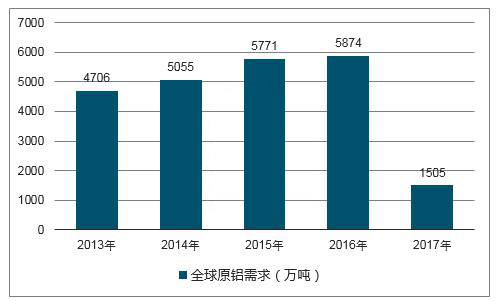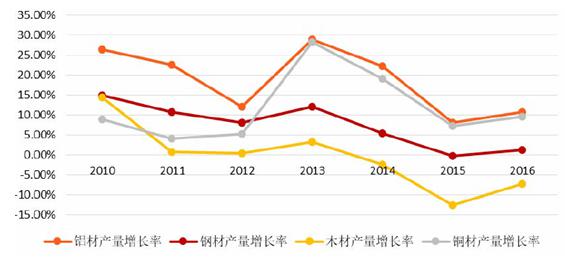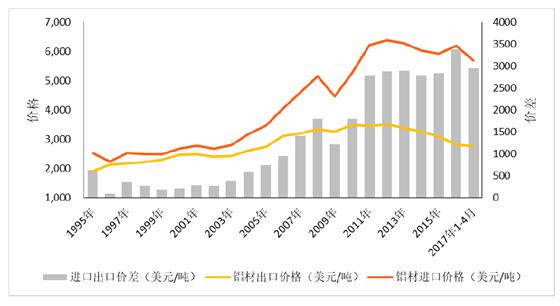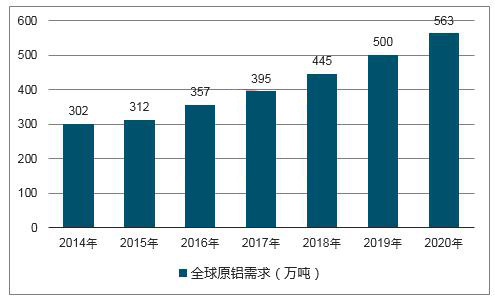Aluminum knowledge
Analysis on the development trend of China's aluminum industry at home and abroad in 2017
Date:2019-01-11 Views:233
(1) development trend of the industry in the world
Since the 1990s, the global industrial precision aluminum alloy parts processing and manufacturing industry has entered a new period of development.The processing capacity is mainly distributed in Europe, North America and Asia, with major production countries including China, the United States, Italy, Japan and Germany.With the gradual completion of the integration process of production capacity survival of the fittest, merger and reorganization in developed countries, as well as the promotion of the globalization process, the whole industry has formed a development trend that is dominated by a small number of multinational enterprises with increasingly concentrated market share in developed countries.
The continuous expansion of the application field of aluminum alloy structural parts and functional parts directly stimulates the growth of global demand for primary aluminum.Global demand for primary aluminum was 58.74 million tons in 2016, up 1.78% from 2015.Global demand for primary aluminum reached 15.05 million tons in the first three months of 2017, up 8.26% from the same period of 2016.
Global demand for primary aluminum

Data source: public information, intelligent research consulting and sorting
Relevant report: Report on Special Research and Investment Direction of China Aluminum Market 2017-2022 issued by Intelligent Research Consulting
(2) Domestic development trend of the industry
① At present, the domestic per capita aluminum consumption level is lower than that of developed countries, and the future aluminum product market has a large development space. According to the statistical data, the average annual composite growth rate of the total apparent consumption of primary aluminum in the world is 2.52% from 2011 to 2015, while the compound growth rate of China's apparent consumption of primary aluminum in the same period is 6.80%, which is higher than the global average. In 2006, China has surpassed the United States as a major global aluminum consumer. By the end of 2016, China's apparent consumption of primary aluminum reached 31825800 tons.
However, from the data of per capita aluminum consumption, there is still a big gap. According to the estimated data of 2016, the per capita aluminum consumption of China was estimated to be 24.1 kg/person, and there are many countries ahead of China. Among them, the United States and Japan reached about 30 kg/person, while Switzerland, Germany and other countries are close to or even more than 40 kg/person. In 2020, China's apparent consumption of primary aluminum will reach 40 million tons, with a compound annual growth rate of 5.2%.
② Compared with other materials, aluminum has certain advantages in some properties and plays an inestimable role in China's industrial development. Aluminum has the advantages of easy processing, low production cost, light weight, high strength and good corrosion resistance. As China's industrial production enterprises pay more attention to the performance and environmental protection of products, aluminum has gradually begun to replace traditional metals such as steel and copper and other materials such as wood in many fields. In 2016, China's aluminum production reached 57.961 million tons, a year-on-year increase of 10.69%, higher than the growth rate of national industrial added value in the same year, and the growth rate of aluminum production in the past three years was higher than that of copper, steel and wood. China's large aluminum extrusion processing enterprises are mainly distributed in Guangdong, Liaoning, Shandong, Henan, Jiangsu and other provinces and regions, and the output of the above five provinces accounts for about 70% of the total output of the country. In the future, the production of aluminum products may still increase at a rate of about 6%. It is estimated that the production and sales of aluminum products will exceed 55 million tons per year by 2020.
Comparison of output growth rate of different industrial materials

Data source: sorting out public information
③ The domestic aluminum processing industry is developing in the direction of intensive processing.
China's aluminum alloy extrusion industry has been developing since the 1950s. After two periods of rapid development in the 60-70s and 80-90s, it is in the third climax of rapid development. During the "Twelfth Five-Year Plan" period, the development of extrusion materials was relatively prominent. The production capacity of extrusion materials accounted for 52% of the aluminum production capacity. In 2016, the production capacity of extrusion materials reached 28.06 million tons. China has become a major country in aluminum extrusion processing and production. However, there is still a certain gap between the development level of China's aluminum industry and that of advanced countries, and the deep processing rate is less than 15%. Good aluminum deep-processed products and their varieties, quality and output are insufficient. Low-end aluminum products are exported in large quantities, while good aluminum products rely on imports. In 2016, the average export price of aluminum products in China was US $2810/ton, and the average price of imported aluminum products was as high as US $6203/ton. The prices of imported and exported aluminum products differed greatly.

(3) Automobile field
① The lightweight trend of traditional cars increases the demand for aluminum in the automotive industry
In recent years, the continuous growth of automobile production, sales and ownership has brought environmental problems to all countries in the world, which has led countries around the world to introduce energy-saving and emission reduction policies. Europe, the United States and Japan have further tightened their vehicle emissions and further improved their fuel efficiency targets. China has also formulated clear energy conservation and emission reduction targets. By 2020, the overall fuel consumption of new passenger vehicles (including new energy passenger vehicles) will be reduced to 5 liters/100 kilometers, and to about 4 liters/100 kilometers in 2025. In order to achieve the goal of energy conservation and emission reduction, automobile lightweight has become one of the key areas of concern for major automobile enterprises. According to the statistical standards of the World Aluminum Association, the total weight of the vehicle is reduced by 10%, and the fuel consumption per 100 kilometers is reduced by 6% - 8%.
In 2016, China's automobile aluminum consumption reached 3.573 million tons, up 14.5% year on year. From 2016 to 2020, the annual compound growth rate of global aluminum consumption for automobiles will be 11.54%, and it will reach 22.52 million tons in 2020. Among them, from 2016 to 2020, the average annual compound growth rate of China's automobile aluminum consumption will be 12.53%, and it will reach 5.63 million tons in 2020.
China's automobile aluminum consumption (10000 tons)

Data source: public information, intelligence research consulting collation
② The continuous growth of the production of new energy vehicles and the improvement of energy consumption standards have stimulated the market demand for aluminum parts. New energy vehicles are growing at a faster pace worldwide due to their environmental friendliness. In 2016, the global total sales of new energy vehicles reached 774000, an increase of 40% year on year, but its share in the global overall automobile market was only about 0.85%, and the market penetration space was still huge. By 2020, the annual output of new energy vehicles in Europe, the United States, Japan, South Korea and medium-sized countries will reach 1.2-2.4 million, accounting for 9% - 20% of the total passenger vehicles.
In 2016, the output of new energy vehicles in China reached 517000, a year-on-year increase of 51.7%, more than 63 times higher than the first published production and sales data in 2011, with an annualized growth rate of 128%. At present, China has surpassed the United States and become a country with large production and sales of new energy vehicles.
Output of new energy vehicles in China

- Last:Analysis on th
- Next:How to solve a



